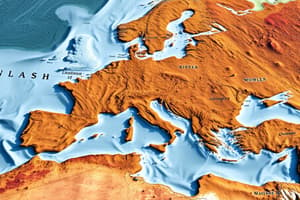Podcast
Questions and Answers
- (correct)
- (correct)
- (correct)
- (correct)
- (correct)
- (correct)
- (correct)
- (correct)
Flashcards are hidden until you start studying
Study Notes
Location in Geography
Definition
- Location refers to a place or position on the Earth's surface, identified by its latitude, longitude, and altitude.
Types of Location
- Absolute Location: A precise location identified by its latitude and longitude coordinates (e.g., 40.7128° N, 74.0060° W).
- Relative Location: A location described in relation to other places or landmarks (e.g., "near the city center").
Components of Location
- Latitude: The distance north or south of the Equator, measured in degrees, minutes, and seconds (e.g., 40° 42' 45" N).
- Longitude: The distance east or west of the Prime Meridian, measured in degrees, minutes, and seconds (e.g., 74° 0' 22" W).
- Altitude: The height above sea level, measured in meters or feet (e.g., 10 m or 33 ft).
Methods of Determining Location
- GPS (Global Positioning System): A satellite-based system that provides precise location coordinates.
- Map Reading: Using maps to determine location based on grid references or landmarks.
- Celestial Navigation: Using astronomical objects to determine location.
Importance of Location in Geography
- Understanding spatial relationships: Location helps us understand how places are connected and how they interact with each other.
- Geographic analysis: Location is essential for analyzing geographic phenomena, such as climate, economy, and culture.
- Navigation and transportation: Accurate location information is crucial for navigation, transportation, and logistics.
地理学中的位置
定义
- 位置是地球表面上的一个点或位置,通过纬度、经度和高程来确定。
位置类型
- 绝对位置:通过经度和纬度坐标确定的精确位置(例如,40.7128° N, 74.0060° W)。
- 相对位置:用相对于其他地方或地标的描述来确定的位置(例如,“市中心附近”)。
位置组成部分
- 纬度:赤道以北或以南的距离,测量单位为度、分和秒(例如,40° 42' 45" N)。
- 经度:格林威治子午线以东或以西的距离,测量单位为度、分和秒(例如,74° 0' 22" W)。
- 高程:海拔高度,测量单位为米或英尺(例如,10 m 或 33 ft)。
确定位置的方法
- GPS(全球定位系统):一種基于卫星的系统,提供精确的位置坐标。
- 地图阅读:使用地图根据网格参考或地标来确定位置。
- 天文航行:使用天体来确定位置。
地理学中位置的重要性
- 理解空间关系:位置有助于我们了解地方之间的联系和交互。
- 地理分析:位置对于分析地理现象,如气候、经济和文化,至关重要。
- 导航和交通:准确的位置信息对于导航、交通和物流至关重要。
Studying That Suits You
Use AI to generate personalized quizzes and flashcards to suit your learning preferences.




